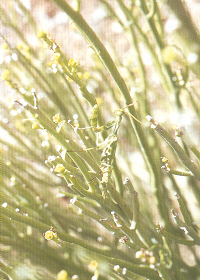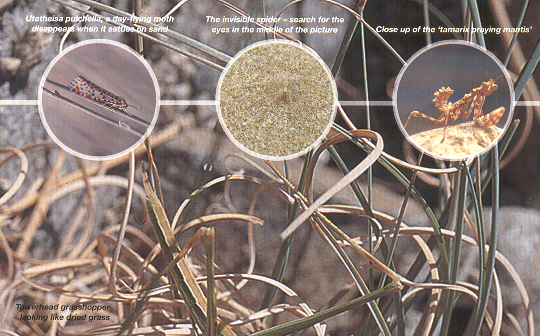|
I
was watching a documentary video that was shot by remote
control camera on Jebel Samhan in Southern Oman. The
scene was a steep hillside with a narrow track that
curved around some boulders. Suddenly there was roar
that seemed to come from one of the boulders. There was
an answering call from the valley below. The ‘calling
boulder’ turned out to be an Arabian leopard, so well
camouflaged that even I, forewarned as well as familiar
with the leopard’s appearance, had not detected it.
Where African leopards have a background colour that
fits the browns and yellows of their habitat of grass
and trees, ‘our’ leopards have perfect camouflage for
their habitat of grey rock and dark shadows.
Most wild animals can blend in with their surroundings –
something that humans never seem able to do! The general
colour scheme in mammals is of a mixture of grey and tan
on top, lighter brown on the flanks and creamy white
underneath. Few wild mammals have any pure white patches
of hair, unless they live in the arctic. The only
exception to this rule is that some species have a
bright white patch on the underside of their tail,
called a flag. This spot is visible when the tail is
raised and is mainly meant as a guide for their young to
follow. When the animal does not want to be noticed, the
tail will be kept down. In other species the tip of the
tail takes on the flag function and can be white, as in
sand foxes.
|
 |
|
Towerhead
grasshopper in varied vegetation |
Reptiles that live closer to the ground have earth
colours, sometimes patterned with black stripes or spots
that can make them disappear in a clump of grass. Most
people have heard about the sand viper that hides under
the sand as it lies in wait for passing prey. Sometimes
you can find the print of its hiding place if you are
out in the early morning before the wind has wiped out
the signs in the sand. The sand viper is sand coloured
and would be hard to spot even if it did not hide under
the sand. Its cousin, the carpet viper, is darker
coloured with a black and sometimes white pattern, which
provides good camouflage when it hides in a bush or
between rocks. These snakes do not need to hide to avoid
being killed, but they need their camouflage so that
their prey does not notice them until they are close
enough to be caught.
The true masters of camouflage, however, are those at
the bottom of the food chain. They need to be able to
‘disappear’ in order to stay alive, unless they can
instil fear by signalling their being poisonous or evil
tasting. This latter ability is less widespread. In the
UAE it occurs for instance in the Diadem butterfly. The
male is black with some white and blue iridescent spots
on its hind wings. The female looks entirely different,
namely like an exact copy of the Plain Tiger butterfly.
Any bird worth its salt knows to avoid Plain Tigers
because they taste terrible. By mimicking the appearance
of the Plain Tiger the female Diadem profits from this
instinctive knowledge.
Most insects have a less complicated manner of survival.
They hide. Or they try to look like something else. One
of my favourites is the caterpillar of a small moth that
builds a cocoon consisting of small twigs around its
vulnerable body. When it feeds on its food plant (Fagonia
spp.) it looks like a small clump of the buff coloured
Fagonia thorns – a foolproof protection against
predators. In fact, I would never have imagined that
something alive was inside the small structure, when I
first came across it, if I had not read about something
like this just the day before. There is a gastropod in
the sea that has a similar strategy: it adorns its shell
with sand grains, bits of seaweed and other debris that
it finds, so that it looks like a (sometimes moving) bit
of seabed.
Another interesting feat of camouflage occurs with the
caterpillar of the already mentioned Plain Tiger
butterfly. When it is very young it is black with an
irregular shaped white spot right across the middle.
When it sits on its green food plant, it is very
conspicuous. Not good for a small morsel like that, you
might think. But what does this slow moving creature
look like: a small bird dropping. And which bird would
think of eating a dropping? Later on in life the
caterpillar takes on very brilliant colours: white,
black and red. Now they are warning colours: “Don’t eat
me, I don’t taste nice”. If threatened, it can give a
warning spurt of its evil-tasting juices from some
glands just behind its head. In the wadis you often find
these caterpillars on food plants that are members of
the carrot family. If you irritate the caterpillar very
lightly - with a blade of grass for instance – it
squirts some drops of the most intense carrot-smelling
fluid that would only appeal to a rabbit.
The same colours of white, red and black are used by a
small day-flying moth, but not as warning colours. It
seems unlikely that black and red spots on a white
background could make a flying insect disappear in a
world of sand and small green bushes. But I found out
that it is perfect camouflage for this moth,
Utetheisa pulchella, when I tried to photograph it.
I would follow it as I saw it flitting from one bush to
the other, taking good notice of where it landed. Then
creeping up to it slowly with my camera at the ready, I
would never see it in time to catch it in repose. Its
coloration made it blend with the sand so well, that the
only times I managed to take a picture of it were when
it landed on green vegetation. It made me reflect on
what sand is made up of - orange, black and cream
coloured grains! The caterpillar of this moth must taste
bad, because it advertises the same red and blacks on a
background of such bright silver that it even reflects
the sunlight!
Praying mantises and grasshoppers are also very good at
disappearing into their surroundings.
Stick insects are in the same family and are represented
by several species in the Emirates. They conform to
their name – they look like jointed twigs as they climb
around in the dun-coloured desert vegetation.

A close cousin of theirs is the Towerhead grasshopper (Truxalis
procera). The first one I saw sat in a clump of
drying grass – still green near the roots but turning
yellow at the ends. The insect was exactly the same:
green near the body turning brown towards the end of its
legs and antennae. Later I saw the same insect in
different surroundings – a light brown one on light
brown rocks, a dark green one with black spots in a dark
green bush with black shadows.
I am not sure if these are all the same species, that
turn colours like a chameleon, or if there are several
different species around.
Once I was taking photographs of the pretty flowers of
the Tamarix bush, when I noticed a rather beautiful
praying mantis on the bush. It was a young one, with its
abdomen still curved upwards. Its coloration was exactly
the same as the colour of the Tamarix flowers, and the
unusual shape of its body fitted the irregular shape of
the sprays of flowers exactly. When the film was
developed I noticed that the insect was present in the
first picture I had taken of the bush, long before I had
noticed what was living on the bush. I had taken it for
one of the flowers!
The absolute champion of camouflage was a spider I found
on a sandy plain some years ago. If it had not moved I
would never have seen it at all. I took a picture and
when it was developed I thought I had missed it after
all. But looking very closely I could just make out the
eight black eyes on its head and the long curves of its
legs – but only because I knew it had to be there. I
should have taken a second picture after placing it on a
dark background.
One tiny camouflaged insect that occurs locally is a
hunter and not a prey. Just like the snakes mentioned
before it lies in wait for prey to come close enough so
that it can pounce and catch it. This is the crab spider
(family Thomisidae) that sits on flowers and has
the same color as the flower petals, so that it is
almost invisible. I have seen them yellow on sunflowers
(only visible when they happen to be sitting on the
heart of the flower), white on the flowers of a blossom,
dusty green on similar-colored Caralluma stems in
the desert, and striped red and yellow on the petals of
the Gaillardia in my garden. As happened before
with the Tamarix mantis, I once photographed a bee on a
white blossom and did not notice the crab spider just
about to pounce, until after I saw the developed
picture!
With such little miracles around us all the time, I can
never understand why anyone would spend their time
reading science fiction! | 